 FY21Q2 | January 2021, Issue #28
|

FEMA released the 2020 National Preparedness Report, which deals only with actions taken in 2019. In its ninth year, this report presents an updated, risk-focused approach to summarizing the state of national preparedness.
The next National Preparedness Report, to be released late in 2021, will explore the impacts of the coronavirus pandemic and evaluate the response to it, reflecting the data that becomes available as the incident continues.
As an annual requirement of Presidential Policy Directive 8 and consistent with the Post-Katrina Emergency Management Reform Act reporting responsibilities, the National Preparedness Report has assessed the nation’s preparedness posture since 2012. This report provides partners across the nation with insights into risks, vulnerabilities and capabilities to support decisions about program priorities, resource allocations and community actions.
The report presents a discussion of the risks the nation faces and how those risks drive the nation’s capability requirements, the nation's capabilities to manage risks, including a high-level overview of the nation’s current capabilities. Also, the report includes initial results for the National Risk and Capability Assessment. The assessment meets requirements of the Disaster Recovery Reform Act of 2018, which involves tiered, capability-specific performance objectives to assess national preparedness.
The 2020 report found that affected communities may not be fully prepared to respond to nationally catastrophic incidents. However, an analysis of shared national capabilities indicates as a whole the nation is closer to achieving its national goals, despite some remaining capability gaps. The report also highlights some of the persistent challenges the nation faces, how the nation is working collectively to solve those challenges and what the nation must continue to do to build on those successes. It also provides a deeper assessment of four identified focus areas: cascading impacts, public-private partnerships, vulnerable populations and housing.
|
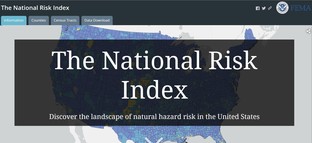
In Nov. 2020, FEMA announced the Phase 1 rollout of the National Risk Index (NRI), a new online resource that helps illustrate communities most at risk from natural hazards. This online mapping application analyzes risk factors from 18 natural hazards. Additionally, to provide a holistic view of community risk, the application includes expected annual losses, social vulnerability, and community resilience layers.
This release makes the underlying data available for use by state, local, tribal and territorial partners. The interactive mapping tool can help communities, especially those with limited flood mapping and risk assessment capabilities, better prepare for natural hazards by providing standardized risk data for mitigation planning and an overview of multiple risk factors. This data can help in developing a FEMA-approved hazard mitigation plan to help increase community resilience, which is a prerequisite requirement for applying for FEMA’s mitigation grants.
The tool determines risk by reviewing a community’s expected annual loss, based on hazard frequency, exposure, and historic loss rate; social vulnerability by measuring the susceptibility of impacted social groups; and community resilience, which measures the ability of a community to recover from, the impacts of natural hazards.
The index contains authoritative data from multiple federal partners and received input from more than 55 partners across the public and private sectors including state, regional and local government agencies; academia; private organizations; and nonprofits. Data were collected from best available resources between 2014 and 2019 and is expected to be updated in 2021.
The tool is free and easy to use, and data from the site is available for download. FEMA is developing a comprehensive National Risk Index application to release later in 2021. Visit FEMA’s National Risk Index webpage to learn more about the data and the natural hazards that can affect your community.
|
In 2020, the West Virginia Silver Jackets planned an extensive outreach campaign to educate state and local partners on relevant resiliency topics. The Silver Jackets teams are across the nation and bring together multiple state, federal, and sometimes local agencies to learn from one another in reducing flood risk and other natural disasters. By applying their shared knowledge, the teams enhance response and recovery efforts disasters occur. No single agency has all the answers but leveraging multiple programs and perspectives can provide a cohesive solution.
Due to COVID-19 restrictions, the team had to reassess plans for the year and scheduled a series of four, 1-hour workshops to discuss current mitigation, preparedness and recovery topics. Over a dozen Silver Jacket partners (state, federal and non-profit) collaborated to plan and host the workshops, and each session had over 50 participants. The goals of the presentations were to educate stakeholders, identify potential resources and technical assistance, and to build relationships between local, state, federal and non-profit partners.
The West Virginia FEMA Integration Team’s (WV FIT) Interagency Recovery Coordination (IRC) Lead, James Young, was able to present on Pre-Disaster Recovery Plans, post-disaster recovery planning and disaster recovery resources. The workshops offered an excellent opportunity to discuss long-term recovery principles, and to identify real world application for COVID recovery operations. The workshops provided a valuable opportunity for WV partners to understand the importance of building resiliency through strategic recovery planning and utilization of disaster recovery funds. Other topics included Public Assistance (PA), HUD Community Development Block Grant – Disaster Recovery (CDBG-DR) and Mitigation (CDBG-MIT), West Virginia Voluntary Agencies Active in Disasters (WV VOAD) programs, and an overview of the West Virginia State Resiliency Office (SRO).
Based upon feedback, the goal is for the WV Silver Jacket team to continue outreach and education efforts in 2021 and offer in-person workshops as restrictions are lifted. Future sessions will be tailored to specific needs of the targeted region and communities. This ongoing dialogue, and sharing of information and resources, is an important step to build relationships between partners that will ultimately help reduce future risk and better prepare West Virginia for future disasters.
The US Small Business Administration (SBA), in consultation with the Treasury Department, re-opened the Paycheck Protection Program (PPP) loan portal to all participating PPP lenders. PPP provides loans to help businesses keep their workforce employed during the Coronavirus (COVID-19) crisis.
Updated PPP guidance outlining Program changes to enhance its effectiveness and accessibility was released on Jan. 6 in accordance with the Economic Aid to Hard-Hit Small Businesses, Non-Profits, and Venues Act. This round of the PPP continues to prioritize millions of Americans employed by small businesses by authorizing up to $284 billion toward job retention and certain other expenses through Mar. 31, 2021, and by allowing certain existing PPP borrowers to apply for a Second Draw PPP Loan.
Key PPP updates include:
- PPP borrowers can set their PPP loan’s covered period to be any length between 8 and 24 weeks to best meet their business needs;
- PPP loans will cover additional expenses, including operations expenditures, property damage costs, supplier costs, and worker protection expenditures;
- The Program’s eligibility is expanded to include 501(c)(6)s, housing cooperatives, destination marketing organizations, among other types of organizations;
- The PPP provides greater flexibility for seasonal employees;
- Certain existing PPP borrowers can request to modify their First Draw PPP Loan amount; and
- Certain existing PPP borrowers are now eligible to apply for a Second Draw PPP Loan.
The new guidance released includes:
For more information on SBA’s assistance to small businesses, visit sba.gov/ppp or treasury.gov/cares. Visit https://covid-sb.org/, the official federal resource website for US small businesses affected by COVID-19.
The US Department of Agriculture (USDA) extends the foreclosure and eviction moratorium for Single Family Housing Direct Loan Borrowers through Mar. 31, 2021. The moratorium applies to:
- Initiation of foreclosures or completion of foreclosures in process, excluding vacant and abandoned properties.
- Evictions of borrowers from properties financed with a USDA direct home loan
In addition, Forbearance/Moratorium assistance for up to 180 days (total of 1 year) is available for Direct Loan borrowers experiencing financial hardship due, directly or indirectly, to the COVID-19 emergency.
- Borrowers call and verbally request a payment moratorium. Borrowers have the option to cancel the moratorium at any time or request the moratorium be extended up to an additional 180 days.
- At the end of the 1-year time period, these 502 Direct borrowers can request the moratorium be extended up to an additional year making it a total of 2 years. However, the borrower must submit a moratorium application and meet eligibility criteria to be granted that last year.
For more information on USDA Rural Development’s actions to support customers directly impacted by COVID-19 visit https://www.rd.usda.gov/coronavirus

The US Census Bureau has released an updated version of the interactive data hub on its COVID-19 resource page. The resource page is designed to help federal agencies, businesses and communities make decisions related to the COVID-19 pandemic.
Version 2.0 of the interactive data hub includes:
- Key Demographic and Economic Data in Interactive Dashboards and Analysis Tools
- COVID-19 Specific Estimates
- Access to these Datasets
The Census Bureau added consolidated, organized, and publicly available links to 38 COVID-19-related datasets from other federal agencies, and nonprofit and private sector sources. These datasets provide resources related to business and economics, individuals and households, and government services, and can be used by both government and non-government entities interested in conducing broad analyses of COVID-19 pandemic impacts. Links to datasets are organized by category (business and economics, individuals and households, and government services) and by source.
The Census Bureau provides access to this and all of its resources in support of the coronavirus response effort at this link.
|
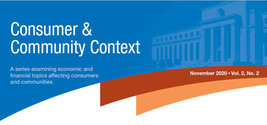
How did U.S. households fare in the early days of the COVID-19 pandemic? Of people working in February who were living in households earning less than $40,000 a year, 39 percent reported they were laid off in March or early April. The Federal Reserve’s fourth issue of Consumer & Community Context features four articles presenting analysis of how consumers, communities and community development organizations have responded to the pandemic.
- The first article looks at select results from the most recent Survey of Household Economics and Decision-making (SHED), originally fielded in October 2019, and from supplemental SHED surveys fielded in April and July 2020 to measure the economic impact of the pandemic.
- The second describes the operations of community development financial institutions and their roles in responding to the pandemic.
- The third presents the results of an analysis of consumer complaints to the Consumer Financial Protection Bureau about their experiences with financial institutions.
- The fourth highlights the results of a survey of organizations providing services to low- and moderate-income communities during the pandemic.
Consumer & Community Context, an article series, features original analysis about the financial conditions and experiences of consumers and communities, including traditionally underserved and economically vulnerable households and neighborhoods. To subscribe to future issues of Consumer & Community Context, or for more information, email CCA-Context@frb.gov. For past issues, visit this link.
|
The U.S. Department of Transportation's Federal Transit Administration (FTA) today announced a total of $14 billion in Federal funding allocations to continue to support the Nation's public transportation systems during the Coronavirus Disease 2019 (COVID-19) public health emergency. Funding is provided through the Coronavirus Response and Relief Supplemental Appropriations Act of 2021 (CRRSAA) (H.R. 133), signed on Dec. 27, 2020. FTA previously announced $25 billion in Coronavirus Aid, Relief, and Economic Security (CARES) Act funding in April 2020.
FTA is allocating $14 billion to recipients of urbanized area and rural area formula funds, with $13.27 billion allocated to large and small urban areas, $678.2 million allocated to rural areas and tribes, and $50 million allocated for the enhanced mobility of seniors and individuals with disabilities. Similar to the CARES Act, the supplemental funding will be provided at 100-percent federal share, with no local match required.
CRRSAA directs recipients to prioritize payroll and operational needs. Funding will also support expenses traditionally eligible under the relevant program. Answers to Frequently Asked Questions about this funding will be available.

The U.S. Environmental Protection Agency (EPA) launched the Clearinghouse for Environmental Finance (Clearinghouse), an online database of land, air, and water information, in December 2020. This new Clearinghouse catalogues available funding, financing, and instructional resources to aid communities in their efforts to improve environmental conditions. EPA’s Water Finance Center manages the Clearinghouse for Environmental Finance. The Center provides information on a suite of water sector financial topics, including through the Water Finance Clearinghouse, coordination among EPA and other federal water funding programs, and specialized support for communities requesting technical assistance for how to afford water infrastructure improvements. Additional information about EPA’s Water Finance Center is available at https://www.epa.gov/waterfinancecenter.
The Clearinghouse expands on the concept of the original Water Finance Clearinghouse, launched in 2017, that served as the one-stop shop for communities researching ways to fund and finance their water infrastructure needs to assist in local decision-making. The new Clearinghouse includes over 1,800 funding and financing opportunities and information resources from EPA’s air, water and land programs. Communities can use this system to access information on funding and financing opportunities for environmental projects as well as financial research, such as case studies, white papers, and webinars.
The public can access the Clearinghouse for Environmental Finance here: www.epa.gov/chef
|
|
|
by Wynne Kwan, Community Planning & Capacity Building Coordinator, FEMA Region 3

Happy New Year, Recovery partners! What a year 2020 was, with the COVID-19 pandemic and the historic Atlantic hurricane season, which was the most active since record-keeping started in 1851.
Although the COVID-19 pandemic is still raging, the FEMA Region 3 COVID-19 Interagency Recovery Coordination Task Force (IRC TF) sunsetted after eight months in operation at the end of December. Key highlights of the IRC TF are as follows:
-
COVID-19’s Impact on the Human and Social Services Sector White Paper resulted from the IRC TF’s work to understand the nature of the problems Region 3 states face regarding social safety nets. It looks at the ways in which this sector has been affected by the pandemic and raises awareness about issues critical to the safety and wellbeing of our citizens and the survival of nonprofit organizations that are straining to meet their needs at this time.
- Through numerous listening sessions with the Planning District Commissions (PDC) and other partners in Virginia, the IRC TF learned that amidst the pandemic’s great challenges, there was much innovation and opportunity. The issues, impacts, opportunities, projects and planning efforts related to COVID-19 recovery identified in the listening sessions have been summarized in Virginia COVID-19 Recovery Issues and Opportunities, which also identifies technical assistance, capacity building, and other support needs, as well as state programs and resources allocations.
Through these initiatives, we have been able to build new relationships with partners in Virginia and nationally that are very important for recovery efforts now and in the future.
As we start 2021 still in the midst of the pandemic, Region 3 continues to support Pennsylvania’s Recovery Support Function (RSF) structure and COVID-19 Long-Term Recovery Task Force to identify longer-term recovery objectives to guide their efforts into 2021. We're also working with our Federal Interagency Partners to highlight available programs and resources to support recovery efforts in our communities. And, lastly, as mentioned in our previous edition of Forward Recovery, we are increasing the frequency of the newsletter to monthly to keep readers informed of the ever-evolving recovery world.
As always, feel free to reach out - either directly or to the Region 3 NDRF mailbox (FEMA-R3-NDRF@fema.dhs.gov). In the meantime, stay safe and take care!
|
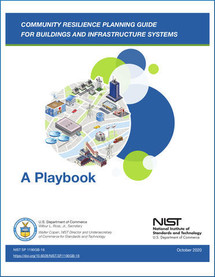
Local officials, businesses, and residents who want to make their communities more resilient to hazard events – natural or otherwise – now can get straightforward, action-oriented guidance from the National Institute of Standards and Technology (NIST).
A 50-page NIST Playbook identifies key actions that communities of any size can take to better position themselves to deal with potential hazards. It complements the two-volume NIST Community Resilience Planning Guide for Buildings and Physical Infrastructure Systems produced in 2015 that is used by communities and professionals in a variety of ways. The Guide recognizes that communities must prioritize their limited resources and that improving resilience is a process achieved over time.
The companion Playbook helps communities follow the Guide’s six-step process, which provides a structured yet flexible way to set community-scale goals, align priorities and resources, identify key stakeholders, and develop plans for recovery of community functions. The Guide and Playbook can assist communities seeking insights into resilience planning issues and help identify the most effective resilience projects and align community plans with resilience goals when seeking funds to support resilience activities.
The Playbook can be used without expert assistance, but also offers ways to engage experts in the planning and implementation stages. It focuses on key actions to accomplish each of the Guide’s six steps for resilience. The Playbook may also be useful for communities that wish to address only several of the steps – or simply to introduce the concept of the Guide’s planning process and the interdependencies of buildings and physical infrastructure systems.
The Playbook has supplemental materials and incorporates the experience of several communities that have put the Guide to use. It also points to complementary materials developed by other federal agencies, non-profit organizations, and states and localities. Appropriate links to sections of the Guide and supporting materials are included in “Useful NIST Resources” at the end of each section.
|
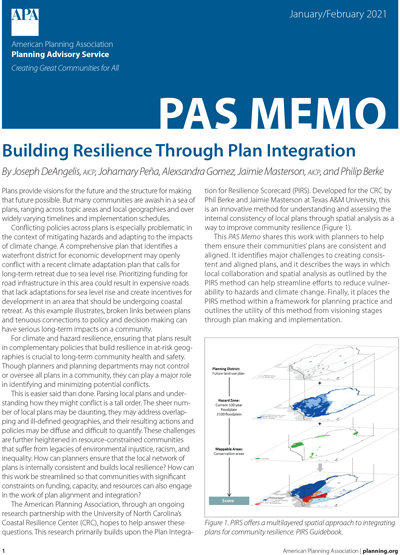
Plans provide visions for the future and the structure for making that future possible. But many communities are awash in a sea of plans, ranging across topic areas and local geographies and over widely varying timelines and implementation schedules. If the policies within these plans conflict, this can be especially problematic in the context of mitigating hazards and adapting to the impacts of climate change.
For climate and hazard resilience, ensuring that plans result in complementary policies that build resilience in at-risk geographies is crucial to long-term community health and safety. Though planners and planning departments may not control or oversee all plans in a community, they can play a major role in identifying and minimizing potential conflicts.
This is easier said than done. Parsing local plans and understanding how they might conflict is a tall order. The sheer number of local plans may be daunting, they may address overlapping and ill-defined geographies, and their resulting actions and policies may be diffuse and difficult to quantify. These challenges are further heightened in resource-constrained communities that suffer from legacies of environmental injustice, racism, and inequality. How can planners ensure that the local network of plans is internally consistent and builds local resilience? How can this work be streamlined so that communities with significant constraints on funding, capacity, and resources can also engage in the work of plan alignment and integration?
This PAS Memo reports on research by the American Planning Association, in partnership with the University of North Carolina’s Coastal Resilience Center, that shows how planners can use the Plan Integration for Resilience Scorecard (PIRS) — an innovative tool developed by Phil Berke and Jaimie Masterson at Texas A&M University for understanding and assessing the internal consistency of local plans through spatial analysis — to improve community resilience and reduce vulnerability to hazards and climate change. Download the PAS Memo at this link.
|
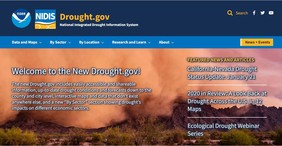
NOAA’s National Integrated Drought Information System (NIDIS) has launched a redesigned US Drought Portal to better serve stakeholders, decision makers, the media, and the public. The new website features updated content and new interactive architecture designed to provide actionable, shareable information and easy-to-understand graphics describing current drought conditions and forecasts by city, county, state, zip code, and at watershed to global scales. The Drought Portal also aggregates and presents drought impact data for economic sectors such as agriculture, energy, water utilities, and recreation using interactive maps and data that don’t exist anywhere else. The portal also has drought conditions down to the city and county level where you can see current conditions, key indicators of drought, outlooks and forecasts, and historical drought conditions. The portal also contains historical data and maps, including U.S. Drought Monitor data going back 20 years.
|

The Eviction Prevention Cohort launched in 2020 as a partnership between National League of Cities (NLC) and Stanford Legal Design Lab (“the Legal Design Lab”) in an effort to assist cities confronting a housing and eviction crisis that disproportionately impacts communities of color. With the onset of the COVID-19 pandemic, the need for cities to design, implement and institutionalize effective policies and programs to combat the root causes of evictions took on a heightened level of importance.
Operating over the course of six months, NLC and the Legal Design Lab led the cities of Grand Rapids, MI; Norfolk, VA; Richmond, VA; Philadelphia, PA; and Pittsburgh, PA in hands-on technical assistance, virtual learning meetings, and peer-to-peer resource sharing and collaboration. By bringing together a diverse group of interconnected stakeholders across each city — including staff from housing and health agencies, legal services, courts, academic, community-based organizations and philanthropy — the participating cities tapped into the full ecosystem of stakeholders working to reduce the risk and impact of evictions.
The program and the efforts of participating cities are detailed at length in The Eviction Prevention Cohort: Highlights from the Five-City Pilot. This report includes specifics about the Cohort and the technical assistance provided and offers a snapshot of the eviction landscape faced by each city. The report also charts a path for expanding, replicating, and refining these efforts. Read the full report here. Click here to read the report. For more information about the Eviction Prevention Cohort, click this link.
|
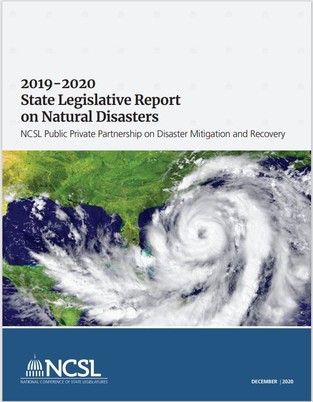
The National Conference of State Legislatures (NCSL) released a new publication from the Public Private Partnership on Disaster Mitigation and Recovery: 2019-2020 State Legislative Report on Natural Disasters.
Informed by in-person and virtual convenings and ongoing coordination among partnership members, this comprehensive new report provides an overview of enacted state disaster legislation for the 2019-2020 legislative session and highlights ways states and federal agency partners can work together to support mitigation activities.
As natural disasters increase in frequency and intensity, state policy has become a primary conduit for solutions. Disaster seasons of the last few years have broken records across the board. Hurricanes Harvey, Irma and Maria and over a dozen others made 2017 the costliest hurricane season on record. The nation’s deadliest and most destructive wildfire season was 2018 and 2020 featured megafires unlike anything the nation has seen. According to the National Oceanic and Atmospheric Administration, the nation averaged nearly 12 “billion-dollar” disasters annually over the past decade―up from less than five per year between 1980 and 2009. Total damages over the past five years exceeded $525 billion—an annual average of around $106 billion.
In the face of these growing costs, state legislatures are balancing competing priorities to fund and reform disaster mitigation and recovery in their states. In 2019 and 2020, states enacted over 200 bills relating to natural disasters. At least 70 of these bills improve infrastructure resilience, from roads and bridges to the energy grid, building codes and emergency communications. At least 100 bills enact broad emergency management reform from administrative changes to intergovernmental coordination and transparency.
Despite the ongoing challenge of balancing competing priorities for limited funding within state budgets—made no simpler by historic pandemic-induced budget shortfalls—over two-thirds of states enacted at least 95 bills appropriating funds or creating financial incentives for resilience activities. This report discusses state legislative trends in broad emergency management reform, finance and appropriations and infrastructure.
The Disasters Partnership was established in the wake of the 2017 disaster season, which highlighted both challenges and opportunities within intergovernmental coordination, public policy, and the role of the private sector in emergency management. The partnership brings state legislators representing disaster-affected districts, or serving as their chamber’s public safety chairs, together with expert legislative staff and private sector partners to explore disaster policy solutions. This and other partnership resources, partnership membership, and schedule of partnership activities are also available on the partnership’s webpage.
|
 |
Source: FEMA National Flood Hazard Layer
FEMA Region 3 First in Country to Achieve 100 Percent Digital Flood Risk Mapping
With Lackawanna County (PA)’s newly published flood maps, FEMA Region 3 became the first region in the country with “wall-to-wall coverage” of digital flood maps.
The transition to digital flood hazard maps is the latest step in a long history of flood risk mapping by the federal government. The United States Geological Survey (USGS) first started publishing flood inundation maps in 1959. The Department of Housing and Urban Development’s Flood Insurance Administration was then tasked with producing countywide Flood Insurance Rate Maps (FIRMs) in 1973, and FEMA became responsible for producing FIRMs in 1979. In 2003, after years of strategic planning, FEMA began moving forward with its Flood Map Modernization program. The digital maps produced by this initiative are more accurate than paper maps and are easier to use and maintain. Since 2009, FEMA has expanded its focus to address the full cycle of risk communication with its Risk Mapping, Assessment and Planning (Risk MAP) program. Currently, digital flood data covers over 90 percent of the U.S. population and is easily searchable via the National Flood Hazard Layer. Using this data, communities can prioritize mitigation actions and property owners can take steps to protect their homes and businesses.
The new Lackawanna County FIRM replaced paper flood maps made with data dating back to the 1970s. Up-to-date maps are critical to building resiliency to flood risk in Lackawanna County, which has a long history of flooding that includes severe damage from hurricanes Diane, Agnes and Gloria, and over 20 flood-related presidential disaster declarations.
MaryAnn Tierney, FEMA Region 3 Regional Administrator, emphasized the importance of using the newly complete digital information: “While we are proud to be the first FEMA region with digital flood maps for all of our communities, the most important thing is that we use this information to make our communities safer,” said Ms. Tierney. “The value in having digital flood maps is that it makes vital information easily accessible to everyone. Residents, local officials and state emergency managers can use these flood maps to make critical decisions that protect their communities and families.”
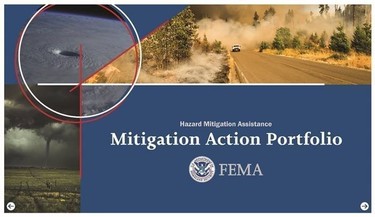
New Mitigation Action Portfolio Showcases Pre-Disaster Mitigation Projects
FEMA recently published the Hazard Mitigation Assistance (HMA) Mitigation Action Portfolio to share information on successful pre-disaster mitigation (PDM) projects and help communities win funding for their own projects.
In September, FEMA announced a new pre-disaster hazard mitigation grant program called Building Resilient Infrastructure and Communities (BRIC). The HMA Mitigation Action Portfolio not only introduces the BRIC program, it also highlights successful pre-disaster hazard mitigation projects from across the country. These case studies show the broad range of possible projects that can be funded. Each case study includes a summary and project details such as cost, primary and secondary benefits, partnerships, project timelines, challenges and resources. Mitigation topics include coastal and inland flooding, drought, wildfire and other natural hazards.
BRIC is part of the National Mitigation Investment Strategy, which is FEMA’s national strategy for increasing mitigation investment to reduce risks from natural hazards. Replacing the existing PDM program, BRIC is intended to invest in projects that use innovative partnerships to produce multiple resiliency benefits. FEMA hopes the portfolio will inspire applicants to consider additional benefits beyond protecting life and property from disasters and think boldly when it comes to building resilient communities.
|
FEMA Publishes New Story Map and Mitigation Planning Success Stories
The FEMA Mitigation Planning Program helps communities prevent the impacts of natural disasters by providing training, tools and resources to help them plan for and reduce their natural hazard risk. Their story map and success stories highlight mitigation plans that go above and beyond the minimum planning requirements. These successes can be duplicated in other communities to build resilience and reduce future disaster losses. Communities featured include Baltimore, Maryland; Portland, Oregon; Manitou Springs, Colorado; Marshfield, Massachusetts; Franklin County, Pennsylvania; New York City, New York; Snohomish County, Washington; and Lincoln, Nebraska. If you have a success story worth sharing, send an email to FEMA-Mitigation-Planning@fema.dhs.gov.
|
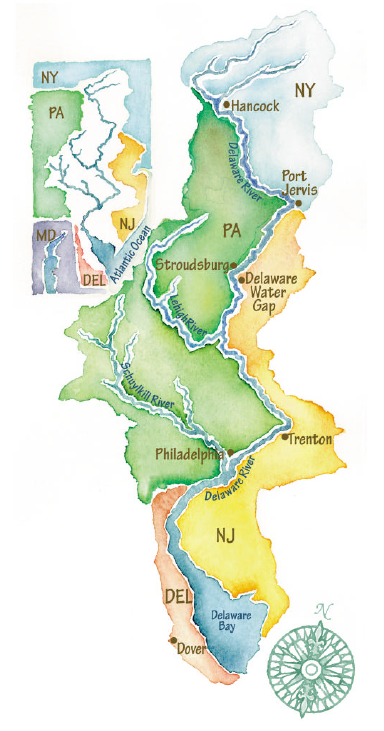
Delaware River Basin Commission Takes Interstate Approach to Climate Change Threats
The Delaware River Basin Commission (DRBC) is a unique federal-interstate agency charged with overseeing a coordinated approach to water resources management in the watershed draining to the Delaware River and Delaware Bay. More than eight million people call this watershed home, and more than 13 million rely on its waters for their everyday needs. The DRBC brings together commissioners from New York, Pennsylvania, New Jersey, Delaware and the U.S. Army Corps of Engineers to cooperatively manage and improve these waters. Program areas include water quality protection, water supply allocation, regulatory review (permitting), water conservation, watershed planning, drought management, flood loss reduction, and recreation.
In late 2019, the DRBC created a new advisory committee to evaluate the threats posed by a changing climate and recommend coordinated measures to adapt to these threats. The Advisory Committee on Climate Change (ACCC) is tasked with providing scientifically based information to assess climate change vulnerabilities in the Delaware River Basin and to identify measures for mitigation, adaptation and resiliency. Vulnerabilities may include changes in the salt front in the tidal Delaware River (which could bring saltier waters to major water supply intakes), changes in the frequency and severity of flooding and droughts, and changes in habitat quality.
This year, DRBC selected 18 climate experts from its member states representing government, academia, business, scientists and watershed groups. The inaugural meeting of the ACCC took place in August and focused on reviewing the commission’s previous and ongoing projects related to climate conditions. The interdisciplinary members of the advisory committee will provide valuable climate and water resources insight as DRBC pursues an interstate approach to planning for changing future conditions.
|
Farm Business Management and Benchmarking Competitive Grants Program
The Farm Business Management and Benchmarking (FBMB) Competitive Grants Program helps to improve the farm management knowledge and skills of agricultural producers by maintaining and expanding a national, publicly available farm financial management database. Applications are due on Apr. 8, 2021. For more information, check out the FBMB Competitive Grants Program webpage.
Opportunity Appalachia Investor Convening
Feb. 23-24, 2921; 1:00-5:00 p.m.
The Opportunity Appalachia Investor Convening is designed to link portfolio projects to potential investors. Pre-vetted national Impact investors and Opportunity Funds (QOFs) with compatible interests will be invited to attend, as will local OZ investors in target communities, federal and state grant makers, lenders (banks and CDFIs), and New Markets Tax Credit funds. The event will include pitches from investment-ready OZ communities. Features include:
- Investment Pitches from 16 participating Opportunity Appalachia communities / project sponsors seeking over $235M in financing for downtown development, rural communities, and operating businesses.
- Web Platform hosting project prospectus on a curated platform to support investor review pre-event.
- Investor Education Panel with national OZ expert attorneys and accountants.
- Investor Panels featuring OZ investors, CDFIs, New Markets Tax Credit investors, as well as federal and state grant makers.
- Private virtual ‘rooms’ for investor meetings; cocktail hour!
- Community Panel and discussion on ‘What We’ve Learned’.
- Leading national sponsors — including banks, federal agencies and regulators, philanthropy, and others.
- Participation with Federal Reserve Bank – Investment Connection
For more information and to register, click here.
Rural Health and Safety Education Competitive Grants Program
The Rural Health and Safety Education Competitive Grants Program (RHSE) Improves the quality of life in rural communities by providing the essential knowledge necessary for successful programs of rural development. RHSE program proposals are expected to be community-based outreach education programs, such as those conducted through Human Science extension outreach that provide individuals and families with:
- Information as to the value of good health at any age; information to increase individual or family’s motivation to take more responsibility for their own health;
- Information regarding rural environmental health issues that directly impact human health;
- Information about and access to health promotion and educational activities; and
- Training for volunteers and health services providers concerning health promotion and health care services for individuals and families in cooperation with state, local, and community partners.
Applications are due on Apr. 29, 2021. Click here for more information on the RHSE funding opportunity
Children, Youth, and Families at Risk (CYFAR) Sustainable Community Projects
The National Institute of Food and Agriculture (NIFA), USDA announces the Children, Youth, and Families at Risk (CYFAR) funding program to improve the quality and quantity of comprehensive community-based programs for at-risk children, youth, and families supported by the Cooperative Extension System. The CYFAR program mission is to marshal resources of the Land-Grant and Cooperative Extension Systems to develop and deliver educational programs that equip limited resource families and youth who are at-risk for not meeting basic human needs with the skills they need to lead positive, productive, contributing lives. Applications are due on Feb. 19, 2021. Click this link for more information on the CYFAR funding opportunity.
Enhancing Agricultural Opportunities for Military Veterans Competitive Grants Program.
The Enhancing Agricultural Opportunities for Military Veterans Program provides grants to non-profits to increase the number of military veterans gaining knowledge and skills through comprehensive, hands-on and immersive model farm and ranch programs offered regionally that lead to successful careers in the food and agricultural sector. The program encourages the development of training opportunities specifically designed for military veterans. AgVets projects will offer onsite, hands-on training and classroom education leading to a comprehensive understanding of successful farm and ranch operations and management practices. Projects may also offer workforce readiness and employment prospects for service-disabled veterans. Ensuring there are pathways for military veterans interested in pursuing careers in agriculture — regardless of age or production choice — strengthens agricultural production and rural economies across the United States. NIFA requests applications for the AgVets to provide grants to nonprofit organizations for training programs and services to establish and enhance farming and ranching opportunities for military veterans. Closing Date: Tuesday, Mar. 23, 2021. More information is available at this link.
Strategic Economic and Community Development
Strategic Economic and Community Development (SECD) funding is authorized through a Farm Bill provision that supports regional economic and community development planning. SECD supports projects that promote and implement strategic community investment plans. These plans use the unique strengths of rural communities to advance prosperity. USDA Rural Development helps finance these projects to build community prosperity by using community assets, identifying resources, convening partners and leveraging federal, state, local or private funding.
USDA is offering a webinar on Tues., Feb. 9, 4:00-5:00 p.m. to provide information about the Fiscal Year 2021 funding opportunity known as Strategic Economic and Community Development (SECD). This webinar will introduce attendees to the Innovation Center, provide an overview of Farm Bill changes to SECD and highlight the FY 2021 application requirements and process. Click this link to register for the webinar. Click on this link to learn more about this funding opportunity.
National Environmental Education Foundation Restoration & Resilience COVID Recovery Fund
The National Environmental Education Foundation (NEEF) is pleased to announce $128,000 in grant funding to support public lands that have been impacted by increased use during the COVID-19 pandemic. With social distancing regulations in place, people are turning to the outdoors more than ever for exercise and rejuvenation. At the same time, the agencies and organizations responsible for maintaining public lands are hampered by reductions in staff, volunteers, and resources, leaving them ill-equipped to keep up with increased human presence in these delicate ecosystems on top of existing maintenance backlogs. In response, NEEF has established the Restoration & Resilience COVID Recovery Fund to help restore these special places by distributing resources and mobilizing volunteers.
Through this funding, NEEF will sponsor public lands sites in order to:
- Demonstrate the need for volunteer service to restore public lands that have been impacted by increased use during the COVID-19 pandemic.
- Engage volunteers in restoration and conservation projects that address the impacts of the pandemic.
- Contribute to improvement of the sponsored public land sites through community engagement, as evidenced by volunteer participation numbers, types of projects, value of volunteer service, and conservation outputs.
Remaining award notifications are May 15, 2021 and Jul. 15, 2021. Applications must be submitted by Apr. 1, 2021 and Jun. 1, 2021, respectively. More information can be found at this link.
Universal Service Administrative Company Rural Health Care Telecommunications Program
The Telecom Program provides reduced rates to rural health care providers for telecommunications and voice services for the use of telemedicine and telehealth. Eligible services are discounted at the difference in cost between urban and rural areas in your state. Application Deadline: Apr. 1, 2021. Click this link for more information.
Community Food Projects (CFP) Competitive Grants Program
In FY 2020 and FY 2021, NIFA's CFP intends to solicit applications and fund two types of grants. The types are entitled (1) Community Food Projects (CFP) and (2) Planning Projects (PP). The purpose of the CFP is to support the development of projects with a one-time infusion of federal dollars to make such projects self-sustaining. CFPs are designed to create community-based food projects with objectives, activities and outcomes that are in alignment with Community Food Projects Competitive Grants Program (CFPCGP) primary goals. The purpose of a Planning Project (PP) is to complete a plan toward the improvement of community food security in keeping with the primary goals of the CFPCGP. PPs are to focus on a defined community and describe in detail the activities and outcomes of the planning project. Applications are due on May 4, 2021. Click this link for more information.
USDA Seeks Applications for Grants to Support Rural Community Development Projects
United States Department of Agriculture (USDA) is seeking grant applications for projects to improve housing, community facilities, and community and economic development in rural areas. Subject to the availability of funds, grants will be established through USDA’s Rural Community Development Initiative (RCDI) program. Eligible recipients include public bodies, nonprofit organizations, and qualified private (for-profit) organizations. Applications are due on Mar. 22, 2021. Click this link for more information.
USDA Rural Development Community Facilities Technical Assistance and Training Grant
USDA Rural Development will make grants to public bodies and private nonprofit corporations, (such as States, counties, cities, townships, and incorporated towns and villages, boroughs, authorities, districts, and Indian tribes on Federal and State reservations) to provide associations Technical Assistance and/or training with respect to essential community facilities programs. The Technical Assistance and/or training will assist communities, Indian Tribes, and Nonprofit Corporations to identify and plan for community facility needs that exist in their area. Once those needs have been identified, the Grantee can assist in identifying public and private resources to finance those identified community facility needs. Applications are due on Mar. 22, 2021. Click this link for more information.
|
TOOLS, TRAININGS, AND RESOURCE UPDATES
Webinars
Focus on Aging Webinar: Workforce to Support the Needs of Older Adults. Feb 2, 2:00-3:30 p.m.
Recovering Stronger: Transforming Water Management in America. Feb. 4, 1:00-2:00 p.m.
County Eviction Series: Solutions from Across the Country. Feb. 4, 2:00-3:00 p.m.
Fighting Food Insecurity During COVID-19 and Beyond: Key Updates for County Leaders. Feb. 5, 2:00-3:15 p.m.
Vaccine Management Solutions for Local Governments. Feb. 5, 3:00-4:00 p.m.
How to Bring Democratic Decision-Making to Authentic Community Engagement. Feb. 10; 1:00-2:00 p.m.
The COVID-19 Pandemic and State and Local Budgets: Past, Present, and Future. Feb. 10, 2:00-3:30 p.m.
The COVID-19 Vaccine Rollout and the Impact on States and Municipalities. Feb. 11; 11:00-noon
Rural Broadband and Telehealth Financing. Feb. 16, 2:00-3:00 p.m.
Data as the Foundation for Broadband Planning. Feb. 17, 2:00-3:00 p.m.
Restoring the Hospitality Industry. Apr. 20, 2:00-3:00 p.m.
Preserving Local Economies with Energy and Water Finance. Jun. 15, 2:00-3:00 p.m.
Equity By Design Global Dialogue Series (11-Noon)
- Include Age-Friendliness in Other Priorities and Lead Cross-Sector Collaboration. Feb 25
Council of Development Finance Agencies (CDFA) Federal Financing Webinar Series (2:00-3:00 p.m.)
- Restoring Local Economies with Federal Partners. Feb. 9
- Expanding Capital Access to Preserve Small Businesses. Mar. 9
- Federal Programs for Affordable Housing Investment. May 11
- Federal Financing for Energy and Water Systems. Jun. 8
- Investing in Critical Community Facilities. Aug. 24
- The Federal Role in Financing Broadband. Sept. 14
- Preserving Local Food Systems with Federal Financing. Dec. 14
FEMA Region 3 Coffee Break Mitigation Webinars (11:00 a.m.-12:00 p.m.)
- Connecting Climate Change to Hazard Mitigation Planning. Mar. 17
- Exploring Approaches to Plan Integration. May 19
- Identifying Technical Assistance Opportunities and Resources. Jul. 14
- Understanding Mitigation: Preparing for a Zombie Apocalypse. Sept. 29
- Assessing Substantial Damage through Your Hazard Mitigation Plan. Nov. 3
Resources
US Dept. of Energy (DOE) Better Buildings Solution Center
FarmAid: Resources for Farmers Affected by COVID-19
National Digital Inclusion Alliance (NDIA) COVID-19 Resources
National Rural Health Association (NHRA) COVID-19 Resources
SBA Coronavirus (COVID-19): Small Business Guidance & Loan Resources
SBA Recovery Hub
Rural Health Information Hub Rural Funding and Opportunities
Leveraging Development Finance Tools to Attract Opportunity Zone Investment
Housing and Homelessness Resources on COVID-19
USDA Programs in the Local Food Supply Chain
Emerging Best Practices for COVID-19 Emergency Rental Assistance Programs
National League of Cities (NLC) "Cities Are Essential" Tools, Actions, and Resources
Guides
The Planner's Playbook: A Community-centered Approach to Improving Health and Equity
Long-range Planning for Health, Equity, and Prosperity
Guidance
US Treasury Coronavirus Relief Fund Guidance - Jan. 15, 2021
Reports
FEMA Coronavirus Disease (COVID-19) Initial Assessment Report
|
Reports (cont.)
COVID-19 Addendum to Critical Issues in Transportation
Costs of COVID-19 Evictions
Emergency Preparedness Amidst COVID-19
Quantifying the Impact from Climate Change on US Hurricane Risk
Urban Land Institute (ULI) Sustainability Outlook 2021
Building Climate Resilience in Cities Worldwide
Tools/Toolkits
FEMA Emergency Operations Center Toolkit
Rural Community Health Workers Toolkit
Food Access Toolkit
"Community of Immunity" Vaccination Deficit Explorer
Framework for an Equitable COVID-19 Homelessness Response
A Pandemic Playbook for Transportation Agencies
Podcasts
States of Innovation: Natural Solutions for Natural Disasters
Disasters: Deconstructed
Disaster Zone
Building Digitally Equitable Communities
Recorded Webinars
Rural Transit Planning in the Time of COVID and Beyond
Enhancing Fiscal Resilience in a Disruptive Environment: What We've Learned and What's Next
Building Housing Security During COVID-19 and Beyond
|
Conferences
National Association of Regional Councils National Conference of Regions. Feb. 7-10, 2021; Virtual
2021 Cultural Wealth Conference: The Role of the Arts and Cultural Capital in Rural Innovation and Entrepreneurship. Feb. 23, 25, 2021; Virtual
National League of Cities (NLC) Congressional City Conference: Respond. Recover. Rebuild.. Mar. 7-10, 2021; Virtual
International Economic Development Council (IEDC) 2021 Leadership Summit. Mar. 15-16, 2021; Virtual
Urban Land Institute (ULI) Housing Opportunity Conference. Mar. 16-17, 2021; Virtual
National Low Income Housing Coalition Virtual Housing Policy Forum 2021: A New Day. Mar. 30-31, 2021; Virtual
2021 National Planning Conference. May 5-7, 2021; Virtual
Association of State Floodplain Managers 45th Annual National Conference. May 9-13, 2021; Raleigh, North Carolina, and virtual options
Association of Metropolitan Planning Organizations (AMPO) 2021 Planning Tools and Training Symposium. May 17-20, 2021; Ft. Lauderdale, FL
2021 National Hurricane Conference. Jun. 14-17, 2021; New Orleans, LA
2021 Virtual Natural Hazards Workshop and Researchers Meeting. Workshop: Jul. 11-14, 2021, Researchers Meeting: Jul. 14-15, 2021; Virtual
|
Conferences (cont.)
2021 Association of Metropolitan Planning Organizations (AMPO) Annual Conference. Oct. 4-10, 2021; Scottsdale, AZ
Articles of Interest
What Social Media is Telling Us About Local Workforce Development and Infrastructure
Public-private Partnerships are Key to COVID Recovery, say US Mayors
Poverty Grows Despite Economic Recovery
How States Can Help Small Businesses Recover From the Pandemic
How States are Expanding Broadband Access
The COVID-19 Pandemic and Rural America
Strapped Local Governments are Turning to Private Developers for Finance Their Projects
Trainings
K0705: Fundamentals of Grants Management. Virtually Facilitated. Orientation: Feb. 23, 24, or 25. Class: Mar. 1-25
National Center for Disaster Preparedness (NCDP) Web-based Courses
- AWR-357-W: Principles of Community Economic Recovery
- PER-376-W: Preparedness Actions to Promote Economic Resilience and Recovery
- MGT-462: Community Planning for Economic Recovery
|
|
|